Understanding the Dynamics of Travel and Tourism Sector
VerifiedAdded on 2020/01/28
|18
|5972
|103
Report
AI Summary
This report provides a comprehensive analysis of the travel and tourism sector, focusing on its historical development, structure, and the influence of various factors such as government policies, international agencies, and economic policies. It delves into the dynamics of demand and supply, examining the factors influencing tourism demand and how the supply side adapts to meet these demands. Furthermore, the report discusses the social, economic, and environmental effects of tourism, both positive and negative, and proposes strategies to minimize the negative impacts while maximizing the positive ones. The analysis includes a case study of TUI Group, a leading tourism business organization, to illustrate the concepts discussed and provide real-world context. The report aims to provide a thorough understanding of the complexities and importance of the travel and tourism sector.
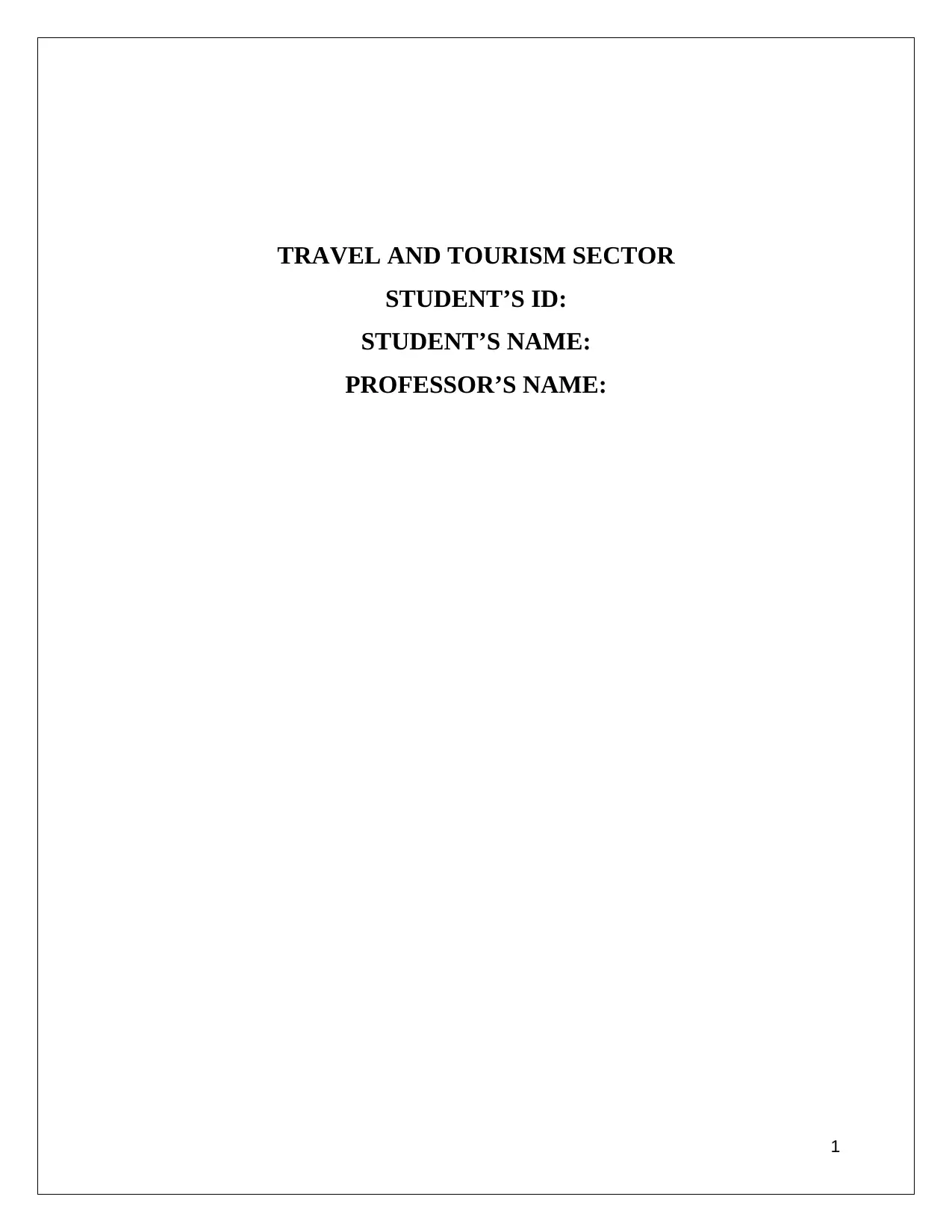
TRAVEL AND TOURISM SECTOR
STUDENT’S ID:
STUDENT’S NAME:
PROFESSOR’S NAME:
1
STUDENT’S ID:
STUDENT’S NAME:
PROFESSOR’S NAME:
1
Paraphrase This Document
Need a fresh take? Get an instant paraphrase of this document with our AI Paraphraser

Table of contents
Introduction......................................................................................................................................3
Overview of the company................................................................................................................3
LO1 Understanding structure and history of tourism sector...........................................................3
1.1 Describing historical development in tourism sector................................................................3
1.2 Discussing tourism sector’s structure........................................................................................6
LO2 Understanding the influence travel and tourism sector...........................................................9
2.1 Travel and Tourism: Effects and Influence of Function of Government, Bodies sponsored by
Government and International Agencies.........................................................................................9
2.2 Local and National Economic Policies : Impacts on Success of Travel and Tourism............10
2.3 Political Change: Implicating Travel and Tourism Across Nations........................................11
LO3 Analysing the impact of demand and supply on tourism sector............................................12
3.1 Analysing factors that are influencing demand for tourism....................................................12
3.2 Describing the change of supply for meeting impact of demand............................................12
LO4 Discussing the effects of tourism..........................................................................................13
4.1 Analysing positive and negative social, economic and environmental effects of tourism......13
4.2 Discussing strategies that can be applied for minimising negative effects and maximising
positive effects...............................................................................................................................15
Conclusion.....................................................................................................................................16
Reference list.................................................................................................................................17
2
Introduction......................................................................................................................................3
Overview of the company................................................................................................................3
LO1 Understanding structure and history of tourism sector...........................................................3
1.1 Describing historical development in tourism sector................................................................3
1.2 Discussing tourism sector’s structure........................................................................................6
LO2 Understanding the influence travel and tourism sector...........................................................9
2.1 Travel and Tourism: Effects and Influence of Function of Government, Bodies sponsored by
Government and International Agencies.........................................................................................9
2.2 Local and National Economic Policies : Impacts on Success of Travel and Tourism............10
2.3 Political Change: Implicating Travel and Tourism Across Nations........................................11
LO3 Analysing the impact of demand and supply on tourism sector............................................12
3.1 Analysing factors that are influencing demand for tourism....................................................12
3.2 Describing the change of supply for meeting impact of demand............................................12
LO4 Discussing the effects of tourism..........................................................................................13
4.1 Analysing positive and negative social, economic and environmental effects of tourism......13
4.2 Discussing strategies that can be applied for minimising negative effects and maximising
positive effects...............................................................................................................................15
Conclusion.....................................................................................................................................16
Reference list.................................................................................................................................17
2

Introduction
Travel and tourism sector is one of the most popular sectors in this world. Travelling plays an
important role in the lives of people because it helps them in learning new and interesting things.
Travellers explore various locations, cultures, history and several other aspects of those places.
The experience of travelling enriches tourists and helps them become wise. The main aim of the
study is to understand the importance of travelling and tourism sector. For the study, a well-
known tourism business organisation, TUI Group is given. In the first sector, the structure and
history of tourism sector are discussed and in the second sector, in the second sector, impact of
international agencies, national and local governments on the tourism sector and evaluated. Then
in the third section, the impact of demand and supply is thoroughly analysed and in the final
section, effects of tourism are described.
Overview of the company
TUI Group is a popular German tourism business organisation, which serve tourists all over the
world. The headquarter of the company is situated in Hanover of Germany. It is the largest travel
and tourism company in this world. TUI Group consists of 16,00 travel agencies, tour operators,
online portals, 300 hotels, 5 four operator airlines, which provide service to tourists from all over
the world. The company gives service to approx. 30 million consumers in almost 180 regions of
this world. In financial year 2015/2016, approx. 67,000 employees worked in the company (Estol
and Font, 2016, p.232). According to the financial report of 2016, TUI Group generated revenue
of €17,184.6 million and the profit was 1,037.4 million.
LO1 Understanding structure and history of tourism sector
1.1 Describing historical development in tourism sector
The historical development of tourism sector is divided into four different periods.
Ancient times:
In the pre-historic era, people used to live in one particular place and they only travelled to
search food or avoid danger. Then people started to travel for the purpose of trading with other
countries. In the Egyptian era, travelling for both entertainment and business started to develop.
After Egyptians, the Persians worked for the improvements of the tourism sector. Then Both
3
Travel and tourism sector is one of the most popular sectors in this world. Travelling plays an
important role in the lives of people because it helps them in learning new and interesting things.
Travellers explore various locations, cultures, history and several other aspects of those places.
The experience of travelling enriches tourists and helps them become wise. The main aim of the
study is to understand the importance of travelling and tourism sector. For the study, a well-
known tourism business organisation, TUI Group is given. In the first sector, the structure and
history of tourism sector are discussed and in the second sector, in the second sector, impact of
international agencies, national and local governments on the tourism sector and evaluated. Then
in the third section, the impact of demand and supply is thoroughly analysed and in the final
section, effects of tourism are described.
Overview of the company
TUI Group is a popular German tourism business organisation, which serve tourists all over the
world. The headquarter of the company is situated in Hanover of Germany. It is the largest travel
and tourism company in this world. TUI Group consists of 16,00 travel agencies, tour operators,
online portals, 300 hotels, 5 four operator airlines, which provide service to tourists from all over
the world. The company gives service to approx. 30 million consumers in almost 180 regions of
this world. In financial year 2015/2016, approx. 67,000 employees worked in the company (Estol
and Font, 2016, p.232). According to the financial report of 2016, TUI Group generated revenue
of €17,184.6 million and the profit was 1,037.4 million.
LO1 Understanding structure and history of tourism sector
1.1 Describing historical development in tourism sector
The historical development of tourism sector is divided into four different periods.
Ancient times:
In the pre-historic era, people used to live in one particular place and they only travelled to
search food or avoid danger. Then people started to travel for the purpose of trading with other
countries. In the Egyptian era, travelling for both entertainment and business started to develop.
After Egyptians, the Persians worked for the improvements of the tourism sector. Then Both
3
⊘ This is a preview!⊘
Do you want full access?
Subscribe today to unlock all pages.

Trusted by 1+ million students worldwide

Romans and Greeks travelled to different places to explore various cultures. When Roman
Empire was collapsed, the roads became unsafe for the travellers. According to Karlsson and
Bryceson (2016, p.138), in the twelfth century, the roads became safe again as huge numbers of
pilgrims started travelling to some specific sites to show honour. In the seventeenth and
eighteenth centuries, the practice of grand tour became popular. The concept was developed in
France and people believed students' education was incomplete if they do not spend 1 to 3 years
travelling various countries of Europe with their tutors.
1440-1479:
During the time of World War II, many people started travelling in different countries. At that
time, business people started to travel in cars and people were also taking vacations with their
family members. Before 1950, the tourism sector was inconsistent and all of the hotels, travel
agencies, tour operators worked separately. Therefore, post-war, factors such as money, time and
interest helped the development of tourism industry at that time. In 1945, the main development
of tourism started and several changes occurred in the industry. In the mid-1950s, in the UK, tour
operators' development began to change the nature of tourism industry (Shen et al. 2016, p.292).
Therefore individual business actions transformed into integrated business activities. At that
time, hotels started to provide several other services along with accommodation. After 1950,
various factors such as availability of time paid holidays, development of package tours helped
in widening the market of the holiday.
1980 to present day:
During 1980, various airlines offered full tourism services including medical services, holidays,
hiring cars. In the 1990s, in the UK and other European countries, the growth of big
organisations affected the tourism sector (Clausen and Gyimóthy, 2016, p.320). The sector of air
travel improved faster as many people started preferring the facility of air travel.
The tourism sector plays a significant role in helping the economy of a country. Therefore, it is
very important for the UK to concentrate on the development and improvement of the tourism
sector and making the next generation ready for getting involved in the business.
4
Empire was collapsed, the roads became unsafe for the travellers. According to Karlsson and
Bryceson (2016, p.138), in the twelfth century, the roads became safe again as huge numbers of
pilgrims started travelling to some specific sites to show honour. In the seventeenth and
eighteenth centuries, the practice of grand tour became popular. The concept was developed in
France and people believed students' education was incomplete if they do not spend 1 to 3 years
travelling various countries of Europe with their tutors.
1440-1479:
During the time of World War II, many people started travelling in different countries. At that
time, business people started to travel in cars and people were also taking vacations with their
family members. Before 1950, the tourism sector was inconsistent and all of the hotels, travel
agencies, tour operators worked separately. Therefore, post-war, factors such as money, time and
interest helped the development of tourism industry at that time. In 1945, the main development
of tourism started and several changes occurred in the industry. In the mid-1950s, in the UK, tour
operators' development began to change the nature of tourism industry (Shen et al. 2016, p.292).
Therefore individual business actions transformed into integrated business activities. At that
time, hotels started to provide several other services along with accommodation. After 1950,
various factors such as availability of time paid holidays, development of package tours helped
in widening the market of the holiday.
1980 to present day:
During 1980, various airlines offered full tourism services including medical services, holidays,
hiring cars. In the 1990s, in the UK and other European countries, the growth of big
organisations affected the tourism sector (Clausen and Gyimóthy, 2016, p.320). The sector of air
travel improved faster as many people started preferring the facility of air travel.
The tourism sector plays a significant role in helping the economy of a country. Therefore, it is
very important for the UK to concentrate on the development and improvement of the tourism
sector and making the next generation ready for getting involved in the business.
4
Paraphrase This Document
Need a fresh take? Get an instant paraphrase of this document with our AI Paraphraser
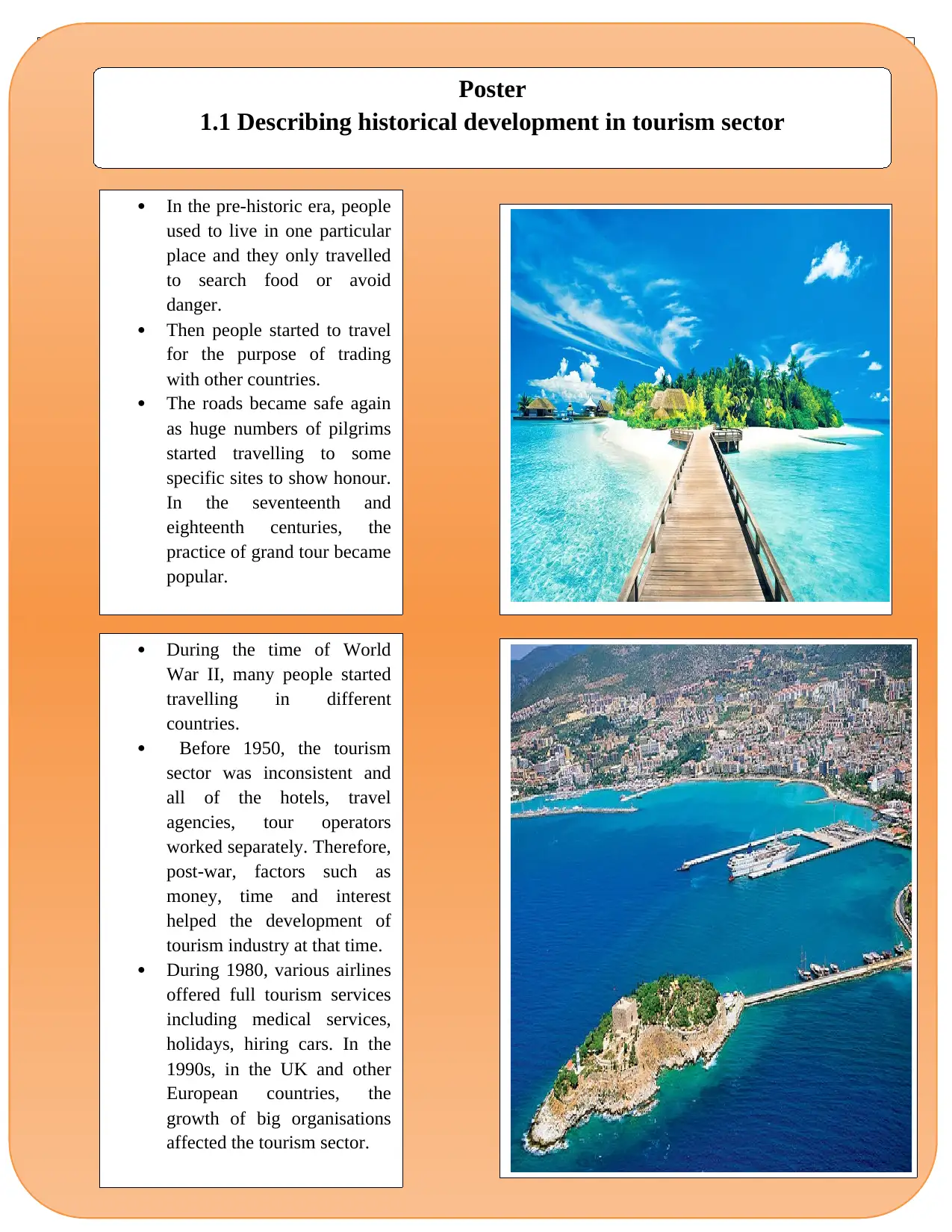
5
Poster
1.1 Describing historical development in tourism sector
In the pre-historic era, people
used to live in one particular
place and they only travelled
to search food or avoid
danger.
Then people started to travel
for the purpose of trading
with other countries.
The roads became safe again
as huge numbers of pilgrims
started travelling to some
specific sites to show honour.
In the seventeenth and
eighteenth centuries, the
practice of grand tour became
popular.
During the time of World
War II, many people started
travelling in different
countries.
Before 1950, the tourism
sector was inconsistent and
all of the hotels, travel
agencies, tour operators
worked separately. Therefore,
post-war, factors such as
money, time and interest
helped the development of
tourism industry at that time.
During 1980, various airlines
offered full tourism services
including medical services,
holidays, hiring cars. In the
1990s, in the UK and other
European countries, the
growth of big organisations
affected the tourism sector.
Poster
1.1 Describing historical development in tourism sector
In the pre-historic era, people
used to live in one particular
place and they only travelled
to search food or avoid
danger.
Then people started to travel
for the purpose of trading
with other countries.
The roads became safe again
as huge numbers of pilgrims
started travelling to some
specific sites to show honour.
In the seventeenth and
eighteenth centuries, the
practice of grand tour became
popular.
During the time of World
War II, many people started
travelling in different
countries.
Before 1950, the tourism
sector was inconsistent and
all of the hotels, travel
agencies, tour operators
worked separately. Therefore,
post-war, factors such as
money, time and interest
helped the development of
tourism industry at that time.
During 1980, various airlines
offered full tourism services
including medical services,
holidays, hiring cars. In the
1990s, in the UK and other
European countries, the
growth of big organisations
affected the tourism sector.
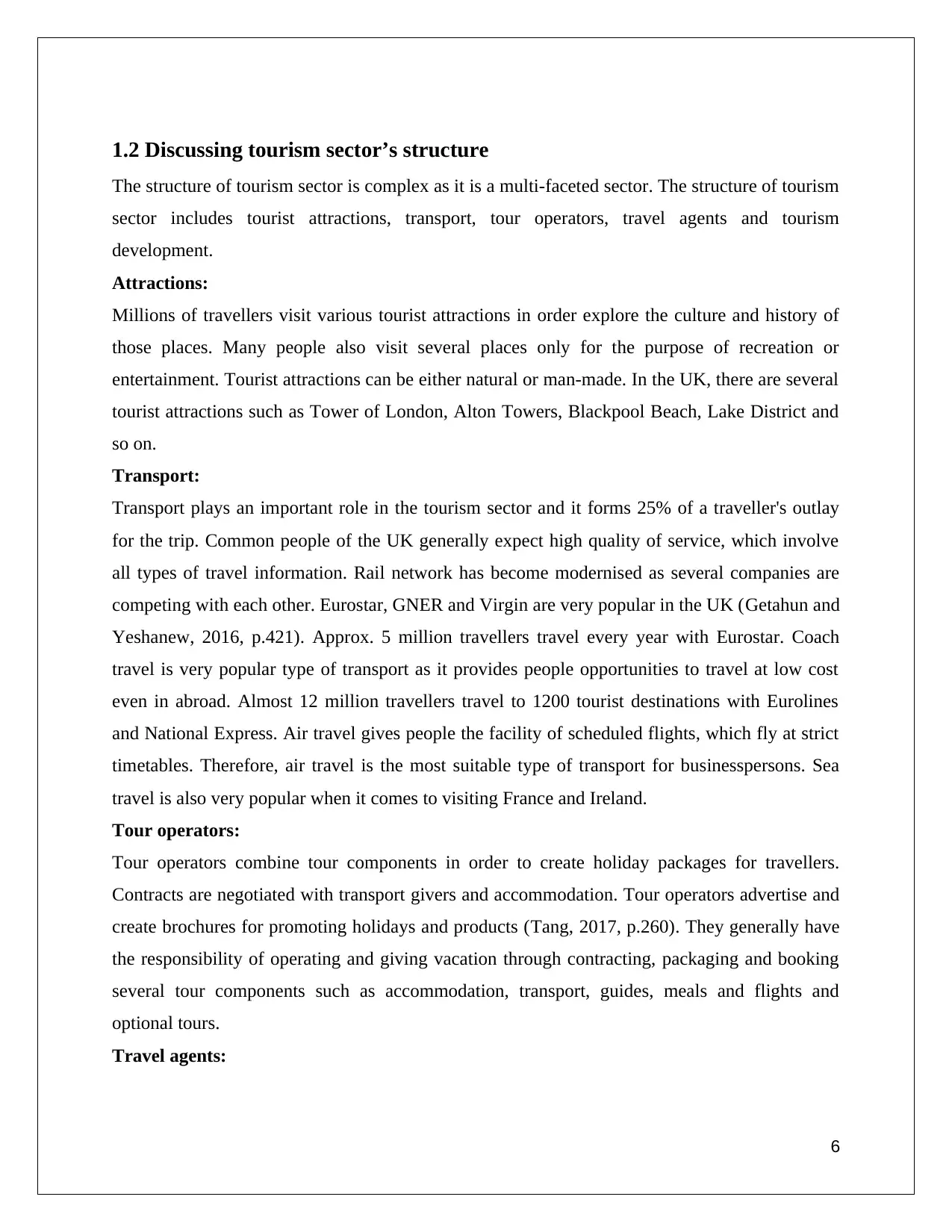
1.2 Discussing tourism sector’s structure
The structure of tourism sector is complex as it is a multi-faceted sector. The structure of tourism
sector includes tourist attractions, transport, tour operators, travel agents and tourism
development.
Attractions:
Millions of travellers visit various tourist attractions in order explore the culture and history of
those places. Many people also visit several places only for the purpose of recreation or
entertainment. Tourist attractions can be either natural or man-made. In the UK, there are several
tourist attractions such as Tower of London, Alton Towers, Blackpool Beach, Lake District and
so on.
Transport:
Transport plays an important role in the tourism sector and it forms 25% of a traveller's outlay
for the trip. Common people of the UK generally expect high quality of service, which involve
all types of travel information. Rail network has become modernised as several companies are
competing with each other. Eurostar, GNER and Virgin are very popular in the UK (Getahun and
Yeshanew, 2016, p.421). Approx. 5 million travellers travel every year with Eurostar. Coach
travel is very popular type of transport as it provides people opportunities to travel at low cost
even in abroad. Almost 12 million travellers travel to 1200 tourist destinations with Eurolines
and National Express. Air travel gives people the facility of scheduled flights, which fly at strict
timetables. Therefore, air travel is the most suitable type of transport for businesspersons. Sea
travel is also very popular when it comes to visiting France and Ireland.
Tour operators:
Tour operators combine tour components in order to create holiday packages for travellers.
Contracts are negotiated with transport givers and accommodation. Tour operators advertise and
create brochures for promoting holidays and products (Tang, 2017, p.260). They generally have
the responsibility of operating and giving vacation through contracting, packaging and booking
several tour components such as accommodation, transport, guides, meals and flights and
optional tours.
Travel agents:
6
The structure of tourism sector is complex as it is a multi-faceted sector. The structure of tourism
sector includes tourist attractions, transport, tour operators, travel agents and tourism
development.
Attractions:
Millions of travellers visit various tourist attractions in order explore the culture and history of
those places. Many people also visit several places only for the purpose of recreation or
entertainment. Tourist attractions can be either natural or man-made. In the UK, there are several
tourist attractions such as Tower of London, Alton Towers, Blackpool Beach, Lake District and
so on.
Transport:
Transport plays an important role in the tourism sector and it forms 25% of a traveller's outlay
for the trip. Common people of the UK generally expect high quality of service, which involve
all types of travel information. Rail network has become modernised as several companies are
competing with each other. Eurostar, GNER and Virgin are very popular in the UK (Getahun and
Yeshanew, 2016, p.421). Approx. 5 million travellers travel every year with Eurostar. Coach
travel is very popular type of transport as it provides people opportunities to travel at low cost
even in abroad. Almost 12 million travellers travel to 1200 tourist destinations with Eurolines
and National Express. Air travel gives people the facility of scheduled flights, which fly at strict
timetables. Therefore, air travel is the most suitable type of transport for businesspersons. Sea
travel is also very popular when it comes to visiting France and Ireland.
Tour operators:
Tour operators combine tour components in order to create holiday packages for travellers.
Contracts are negotiated with transport givers and accommodation. Tour operators advertise and
create brochures for promoting holidays and products (Tang, 2017, p.260). They generally have
the responsibility of operating and giving vacation through contracting, packaging and booking
several tour components such as accommodation, transport, guides, meals and flights and
optional tours.
Travel agents:
6
⊘ This is a preview!⊘
Do you want full access?
Subscribe today to unlock all pages.

Trusted by 1+ million students worldwide
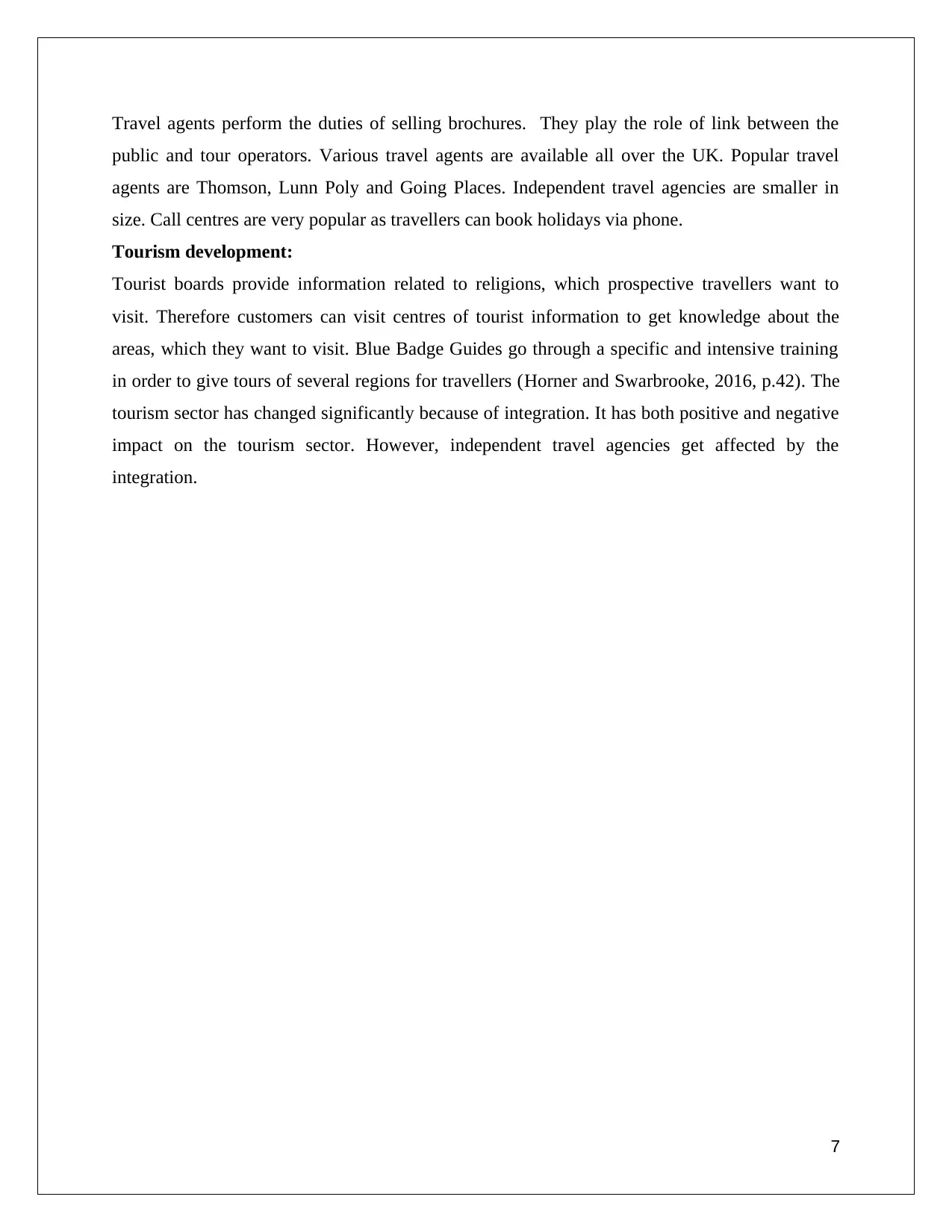
Travel agents perform the duties of selling brochures. They play the role of link between the
public and tour operators. Various travel agents are available all over the UK. Popular travel
agents are Thomson, Lunn Poly and Going Places. Independent travel agencies are smaller in
size. Call centres are very popular as travellers can book holidays via phone.
Tourism development:
Tourist boards provide information related to religions, which prospective travellers want to
visit. Therefore customers can visit centres of tourist information to get knowledge about the
areas, which they want to visit. Blue Badge Guides go through a specific and intensive training
in order to give tours of several regions for travellers (Horner and Swarbrooke, 2016, p.42). The
tourism sector has changed significantly because of integration. It has both positive and negative
impact on the tourism sector. However, independent travel agencies get affected by the
integration.
7
public and tour operators. Various travel agents are available all over the UK. Popular travel
agents are Thomson, Lunn Poly and Going Places. Independent travel agencies are smaller in
size. Call centres are very popular as travellers can book holidays via phone.
Tourism development:
Tourist boards provide information related to religions, which prospective travellers want to
visit. Therefore customers can visit centres of tourist information to get knowledge about the
areas, which they want to visit. Blue Badge Guides go through a specific and intensive training
in order to give tours of several regions for travellers (Horner and Swarbrooke, 2016, p.42). The
tourism sector has changed significantly because of integration. It has both positive and negative
impact on the tourism sector. However, independent travel agencies get affected by the
integration.
7
Paraphrase This Document
Need a fresh take? Get an instant paraphrase of this document with our AI Paraphraser
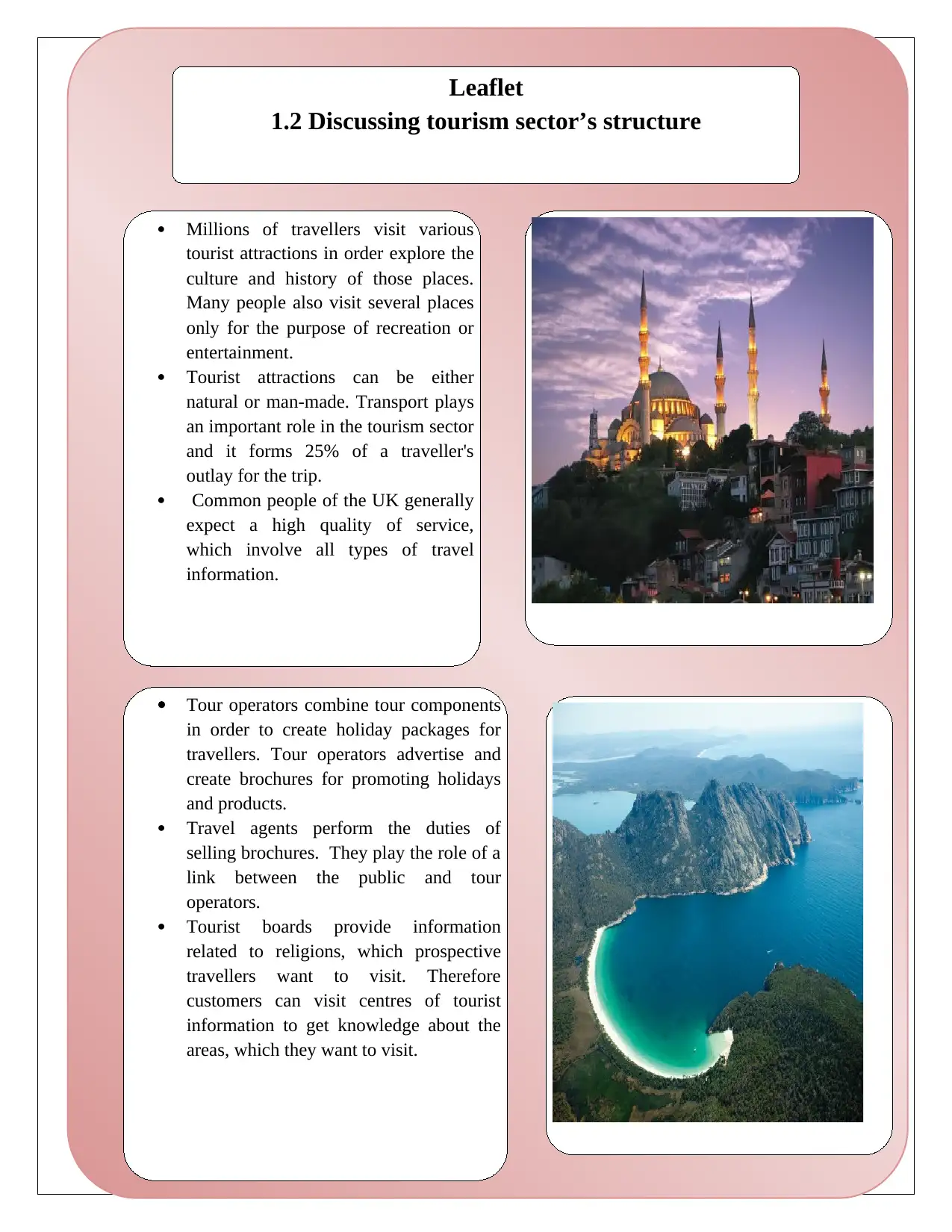
8
Leaflet
1.2 Discussing tourism sector’s structure
Millions of travellers visit various
tourist attractions in order explore the
culture and history of those places.
Many people also visit several places
only for the purpose of recreation or
entertainment.
Tourist attractions can be either
natural or man-made. Transport plays
an important role in the tourism sector
and it forms 25% of a traveller's
outlay for the trip.
Common people of the UK generally
expect a high quality of service,
which involve all types of travel
information.
Tour operators combine tour components
in order to create holiday packages for
travellers. Tour operators advertise and
create brochures for promoting holidays
and products.
Travel agents perform the duties of
selling brochures. They play the role of a
link between the public and tour
operators.
Tourist boards provide information
related to religions, which prospective
travellers want to visit. Therefore
customers can visit centres of tourist
information to get knowledge about the
areas, which they want to visit.
Leaflet
1.2 Discussing tourism sector’s structure
Millions of travellers visit various
tourist attractions in order explore the
culture and history of those places.
Many people also visit several places
only for the purpose of recreation or
entertainment.
Tourist attractions can be either
natural or man-made. Transport plays
an important role in the tourism sector
and it forms 25% of a traveller's
outlay for the trip.
Common people of the UK generally
expect a high quality of service,
which involve all types of travel
information.
Tour operators combine tour components
in order to create holiday packages for
travellers. Tour operators advertise and
create brochures for promoting holidays
and products.
Travel agents perform the duties of
selling brochures. They play the role of a
link between the public and tour
operators.
Tourist boards provide information
related to religions, which prospective
travellers want to visit. Therefore
customers can visit centres of tourist
information to get knowledge about the
areas, which they want to visit.
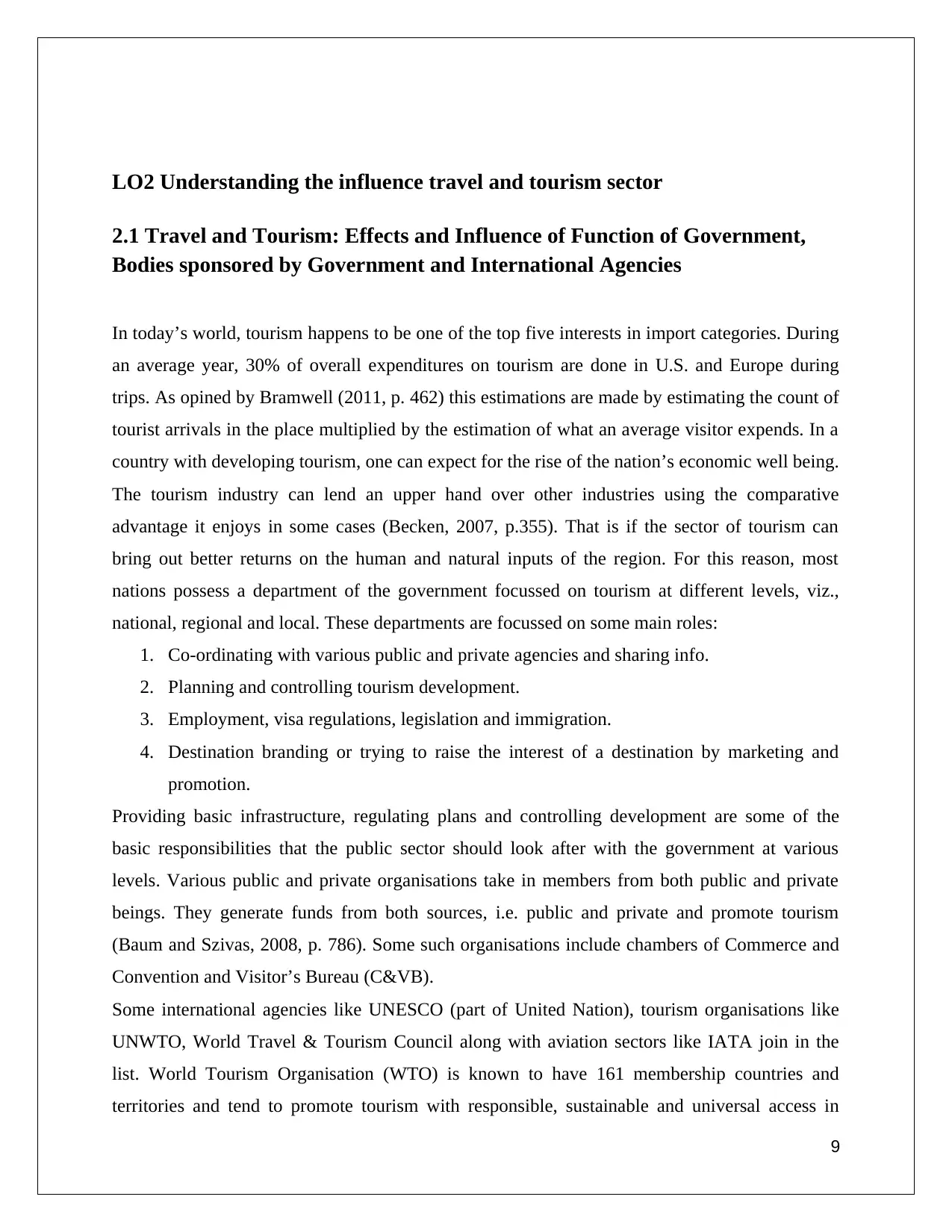
LO2 Understanding the influence travel and tourism sector
2.1 Travel and Tourism: Effects and Influence of Function of Government,
Bodies sponsored by Government and International Agencies
In today’s world, tourism happens to be one of the top five interests in import categories. During
an average year, 30% of overall expenditures on tourism are done in U.S. and Europe during
trips. As opined by Bramwell (2011, p. 462) this estimations are made by estimating the count of
tourist arrivals in the place multiplied by the estimation of what an average visitor expends. In a
country with developing tourism, one can expect for the rise of the nation’s economic well being.
The tourism industry can lend an upper hand over other industries using the comparative
advantage it enjoys in some cases (Becken, 2007, p.355). That is if the sector of tourism can
bring out better returns on the human and natural inputs of the region. For this reason, most
nations possess a department of the government focussed on tourism at different levels, viz.,
national, regional and local. These departments are focussed on some main roles:
1. Co-ordinating with various public and private agencies and sharing info.
2. Planning and controlling tourism development.
3. Employment, visa regulations, legislation and immigration.
4. Destination branding or trying to raise the interest of a destination by marketing and
promotion.
Providing basic infrastructure, regulating plans and controlling development are some of the
basic responsibilities that the public sector should look after with the government at various
levels. Various public and private organisations take in members from both public and private
beings. They generate funds from both sources, i.e. public and private and promote tourism
(Baum and Szivas, 2008, p. 786). Some such organisations include chambers of Commerce and
Convention and Visitor’s Bureau (C&VB).
Some international agencies like UNESCO (part of United Nation), tourism organisations like
UNWTO, World Travel & Tourism Council along with aviation sectors like IATA join in the
list. World Tourism Organisation (WTO) is known to have 161 membership countries and
territories and tend to promote tourism with responsible, sustainable and universal access in
9
2.1 Travel and Tourism: Effects and Influence of Function of Government,
Bodies sponsored by Government and International Agencies
In today’s world, tourism happens to be one of the top five interests in import categories. During
an average year, 30% of overall expenditures on tourism are done in U.S. and Europe during
trips. As opined by Bramwell (2011, p. 462) this estimations are made by estimating the count of
tourist arrivals in the place multiplied by the estimation of what an average visitor expends. In a
country with developing tourism, one can expect for the rise of the nation’s economic well being.
The tourism industry can lend an upper hand over other industries using the comparative
advantage it enjoys in some cases (Becken, 2007, p.355). That is if the sector of tourism can
bring out better returns on the human and natural inputs of the region. For this reason, most
nations possess a department of the government focussed on tourism at different levels, viz.,
national, regional and local. These departments are focussed on some main roles:
1. Co-ordinating with various public and private agencies and sharing info.
2. Planning and controlling tourism development.
3. Employment, visa regulations, legislation and immigration.
4. Destination branding or trying to raise the interest of a destination by marketing and
promotion.
Providing basic infrastructure, regulating plans and controlling development are some of the
basic responsibilities that the public sector should look after with the government at various
levels. Various public and private organisations take in members from both public and private
beings. They generate funds from both sources, i.e. public and private and promote tourism
(Baum and Szivas, 2008, p. 786). Some such organisations include chambers of Commerce and
Convention and Visitor’s Bureau (C&VB).
Some international agencies like UNESCO (part of United Nation), tourism organisations like
UNWTO, World Travel & Tourism Council along with aviation sectors like IATA join in the
list. World Tourism Organisation (WTO) is known to have 161 membership countries and
territories and tend to promote tourism with responsible, sustainable and universal access in
9
⊘ This is a preview!⊘
Do you want full access?
Subscribe today to unlock all pages.

Trusted by 1+ million students worldwide
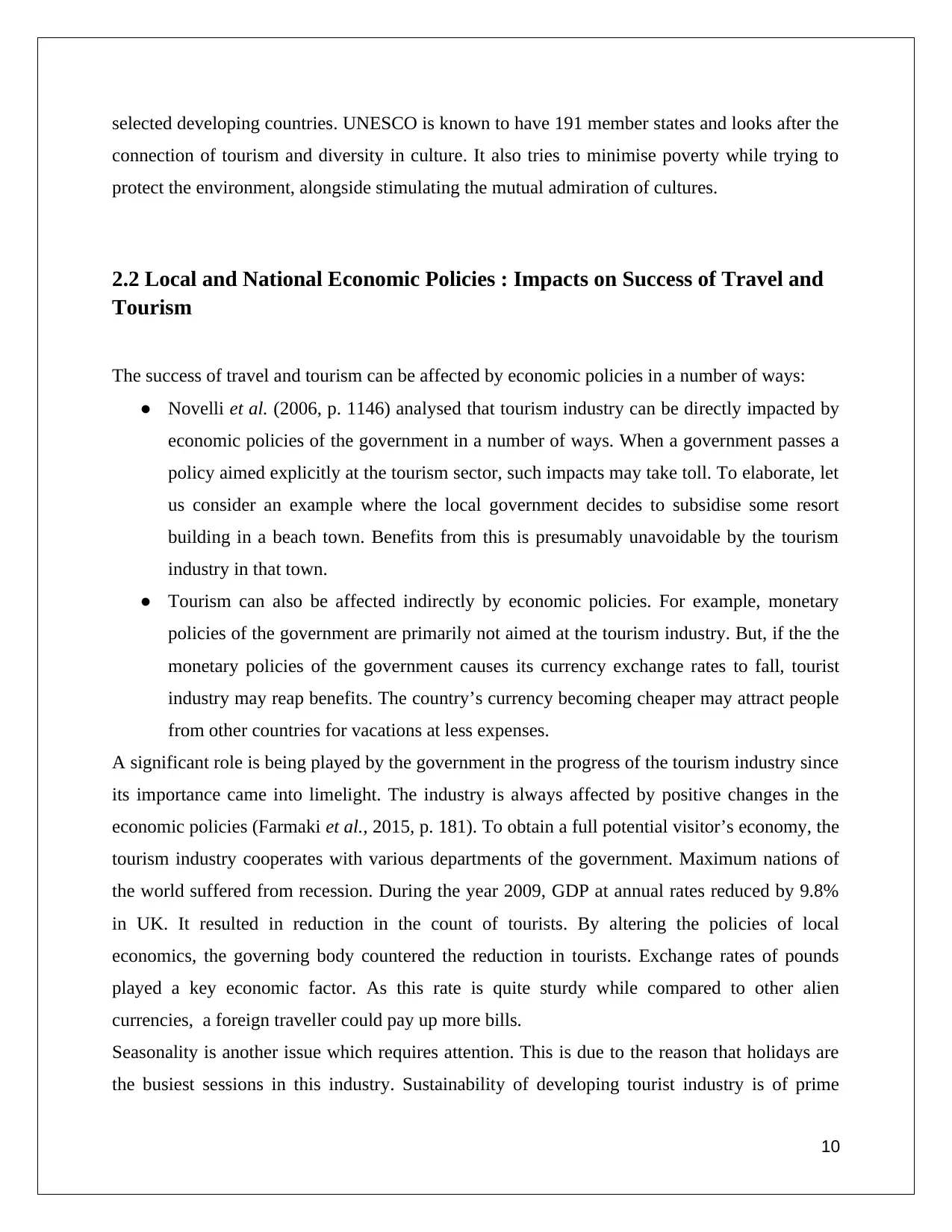
selected developing countries. UNESCO is known to have 191 member states and looks after the
connection of tourism and diversity in culture. It also tries to minimise poverty while trying to
protect the environment, alongside stimulating the mutual admiration of cultures.
2.2 Local and National Economic Policies : Impacts on Success of Travel and
Tourism
The success of travel and tourism can be affected by economic policies in a number of ways:
● Novelli et al. (2006, p. 1146) analysed that tourism industry can be directly impacted by
economic policies of the government in a number of ways. When a government passes a
policy aimed explicitly at the tourism sector, such impacts may take toll. To elaborate, let
us consider an example where the local government decides to subsidise some resort
building in a beach town. Benefits from this is presumably unavoidable by the tourism
industry in that town.
● Tourism can also be affected indirectly by economic policies. For example, monetary
policies of the government are primarily not aimed at the tourism industry. But, if the the
monetary policies of the government causes its currency exchange rates to fall, tourist
industry may reap benefits. The country’s currency becoming cheaper may attract people
from other countries for vacations at less expenses.
A significant role is being played by the government in the progress of the tourism industry since
its importance came into limelight. The industry is always affected by positive changes in the
economic policies (Farmaki et al., 2015, p. 181). To obtain a full potential visitor’s economy, the
tourism industry cooperates with various departments of the government. Maximum nations of
the world suffered from recession. During the year 2009, GDP at annual rates reduced by 9.8%
in UK. It resulted in reduction in the count of tourists. By altering the policies of local
economics, the governing body countered the reduction in tourists. Exchange rates of pounds
played a key economic factor. As this rate is quite sturdy while compared to other alien
currencies, a foreign traveller could pay up more bills.
Seasonality is another issue which requires attention. This is due to the reason that holidays are
the busiest sessions in this industry. Sustainability of developing tourist industry is of prime
10
connection of tourism and diversity in culture. It also tries to minimise poverty while trying to
protect the environment, alongside stimulating the mutual admiration of cultures.
2.2 Local and National Economic Policies : Impacts on Success of Travel and
Tourism
The success of travel and tourism can be affected by economic policies in a number of ways:
● Novelli et al. (2006, p. 1146) analysed that tourism industry can be directly impacted by
economic policies of the government in a number of ways. When a government passes a
policy aimed explicitly at the tourism sector, such impacts may take toll. To elaborate, let
us consider an example where the local government decides to subsidise some resort
building in a beach town. Benefits from this is presumably unavoidable by the tourism
industry in that town.
● Tourism can also be affected indirectly by economic policies. For example, monetary
policies of the government are primarily not aimed at the tourism industry. But, if the the
monetary policies of the government causes its currency exchange rates to fall, tourist
industry may reap benefits. The country’s currency becoming cheaper may attract people
from other countries for vacations at less expenses.
A significant role is being played by the government in the progress of the tourism industry since
its importance came into limelight. The industry is always affected by positive changes in the
economic policies (Farmaki et al., 2015, p. 181). To obtain a full potential visitor’s economy, the
tourism industry cooperates with various departments of the government. Maximum nations of
the world suffered from recession. During the year 2009, GDP at annual rates reduced by 9.8%
in UK. It resulted in reduction in the count of tourists. By altering the policies of local
economics, the governing body countered the reduction in tourists. Exchange rates of pounds
played a key economic factor. As this rate is quite sturdy while compared to other alien
currencies, a foreign traveller could pay up more bills.
Seasonality is another issue which requires attention. This is due to the reason that holidays are
the busiest sessions in this industry. Sustainability of developing tourist industry is of prime
10
Paraphrase This Document
Need a fresh take? Get an instant paraphrase of this document with our AI Paraphraser

focus among most policies. An essential ingredient to the sustainability of this industry is
economic viability.
2.3 Political Change: Implicating Travel and Tourism Across Nations
Since the current and new government legislation affects the tourism entities, it is fundamental to
realise the locus of power in the nation. The location of political power may get shifted in the
future and the effects it might likely have on the policy must be realised (Saha and Yap, 2014, p.
516). The nature of political environment existing in the area can imprint a lot of effects:
● If the party in power belongs to the left wing, i.e. labour and democrat parties, prime
focusses tends to be on the control of free market, trade unions, dynamic taxation,
industries of state ownership, etc. Reducing inequalities of income among individuals as
well as reducing poverty are some of the social mobility goals.
● Right wing parties on the other hand are conservative and republican, believing in the
supremacy of free market. Private industries, anti-trade unions, comparative taxation and
incentive to promote inequality of income are the prime focusses.
Tourism sector of a nation can be widely affected by changes in political scenarios. The basic
changes in legislature can bring insecurity about the safety of tourists, causing them to avoid
such countries. Change in the internal affairs of the tourist’s home nation may also affect tourism
sector in other countries. As per Shone et al. (2016, p.1679) the charm of a country may be
altered by changes in political power. A country may be infamous as unsafe place for visitors
before alterations in their policies of safety. But the result is changed if the country changes its
policies. The nation may slowly recover and rise to a high profile in tourism industry.
Changes in political power may turn a nation into hub of tourism. Safety and regulation of laws
are the major factors influencing the progress of tourism industry. Visitors would enjoy to go to
places where they will be more free, secured and follow less bindings of law. But on the
contrary, if the visa policies are revised by a country to make them more strict, there may be a
possible fall in the count of tourists attracted to that nation.
11
economic viability.
2.3 Political Change: Implicating Travel and Tourism Across Nations
Since the current and new government legislation affects the tourism entities, it is fundamental to
realise the locus of power in the nation. The location of political power may get shifted in the
future and the effects it might likely have on the policy must be realised (Saha and Yap, 2014, p.
516). The nature of political environment existing in the area can imprint a lot of effects:
● If the party in power belongs to the left wing, i.e. labour and democrat parties, prime
focusses tends to be on the control of free market, trade unions, dynamic taxation,
industries of state ownership, etc. Reducing inequalities of income among individuals as
well as reducing poverty are some of the social mobility goals.
● Right wing parties on the other hand are conservative and republican, believing in the
supremacy of free market. Private industries, anti-trade unions, comparative taxation and
incentive to promote inequality of income are the prime focusses.
Tourism sector of a nation can be widely affected by changes in political scenarios. The basic
changes in legislature can bring insecurity about the safety of tourists, causing them to avoid
such countries. Change in the internal affairs of the tourist’s home nation may also affect tourism
sector in other countries. As per Shone et al. (2016, p.1679) the charm of a country may be
altered by changes in political power. A country may be infamous as unsafe place for visitors
before alterations in their policies of safety. But the result is changed if the country changes its
policies. The nation may slowly recover and rise to a high profile in tourism industry.
Changes in political power may turn a nation into hub of tourism. Safety and regulation of laws
are the major factors influencing the progress of tourism industry. Visitors would enjoy to go to
places where they will be more free, secured and follow less bindings of law. But on the
contrary, if the visa policies are revised by a country to make them more strict, there may be a
possible fall in the count of tourists attracted to that nation.
11
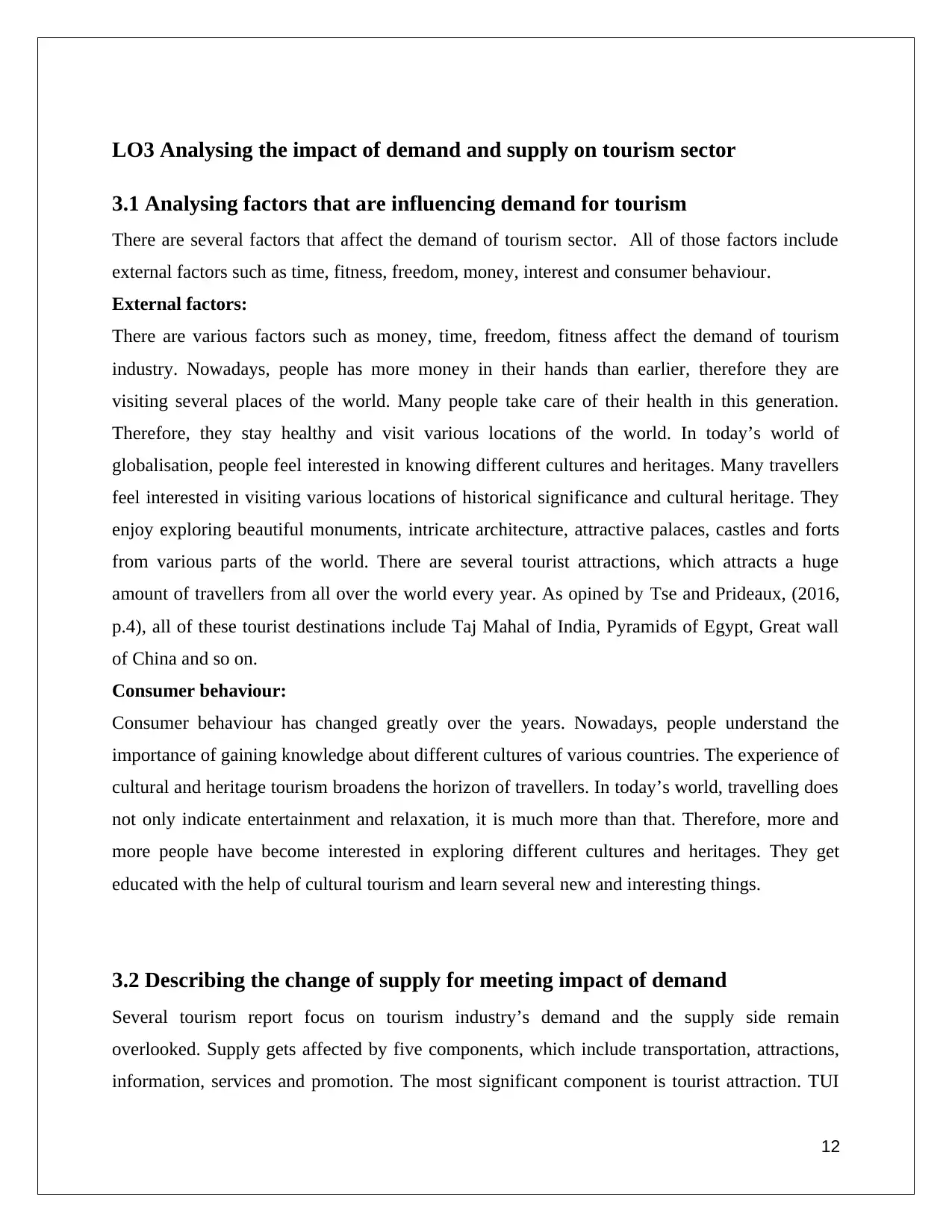
LO3 Analysing the impact of demand and supply on tourism sector
3.1 Analysing factors that are influencing demand for tourism
There are several factors that affect the demand of tourism sector. All of those factors include
external factors such as time, fitness, freedom, money, interest and consumer behaviour.
External factors:
There are various factors such as money, time, freedom, fitness affect the demand of tourism
industry. Nowadays, people has more money in their hands than earlier, therefore they are
visiting several places of the world. Many people take care of their health in this generation.
Therefore, they stay healthy and visit various locations of the world. In today’s world of
globalisation, people feel interested in knowing different cultures and heritages. Many travellers
feel interested in visiting various locations of historical significance and cultural heritage. They
enjoy exploring beautiful monuments, intricate architecture, attractive palaces, castles and forts
from various parts of the world. There are several tourist attractions, which attracts a huge
amount of travellers from all over the world every year. As opined by Tse and Prideaux, (2016,
p.4), all of these tourist destinations include Taj Mahal of India, Pyramids of Egypt, Great wall
of China and so on.
Consumer behaviour:
Consumer behaviour has changed greatly over the years. Nowadays, people understand the
importance of gaining knowledge about different cultures of various countries. The experience of
cultural and heritage tourism broadens the horizon of travellers. In today’s world, travelling does
not only indicate entertainment and relaxation, it is much more than that. Therefore, more and
more people have become interested in exploring different cultures and heritages. They get
educated with the help of cultural tourism and learn several new and interesting things.
3.2 Describing the change of supply for meeting impact of demand
Several tourism report focus on tourism industry’s demand and the supply side remain
overlooked. Supply gets affected by five components, which include transportation, attractions,
information, services and promotion. The most significant component is tourist attraction. TUI
12
3.1 Analysing factors that are influencing demand for tourism
There are several factors that affect the demand of tourism sector. All of those factors include
external factors such as time, fitness, freedom, money, interest and consumer behaviour.
External factors:
There are various factors such as money, time, freedom, fitness affect the demand of tourism
industry. Nowadays, people has more money in their hands than earlier, therefore they are
visiting several places of the world. Many people take care of their health in this generation.
Therefore, they stay healthy and visit various locations of the world. In today’s world of
globalisation, people feel interested in knowing different cultures and heritages. Many travellers
feel interested in visiting various locations of historical significance and cultural heritage. They
enjoy exploring beautiful monuments, intricate architecture, attractive palaces, castles and forts
from various parts of the world. There are several tourist attractions, which attracts a huge
amount of travellers from all over the world every year. As opined by Tse and Prideaux, (2016,
p.4), all of these tourist destinations include Taj Mahal of India, Pyramids of Egypt, Great wall
of China and so on.
Consumer behaviour:
Consumer behaviour has changed greatly over the years. Nowadays, people understand the
importance of gaining knowledge about different cultures of various countries. The experience of
cultural and heritage tourism broadens the horizon of travellers. In today’s world, travelling does
not only indicate entertainment and relaxation, it is much more than that. Therefore, more and
more people have become interested in exploring different cultures and heritages. They get
educated with the help of cultural tourism and learn several new and interesting things.
3.2 Describing the change of supply for meeting impact of demand
Several tourism report focus on tourism industry’s demand and the supply side remain
overlooked. Supply gets affected by five components, which include transportation, attractions,
information, services and promotion. The most significant component is tourist attraction. TUI
12
⊘ This is a preview!⊘
Do you want full access?
Subscribe today to unlock all pages.

Trusted by 1+ million students worldwide
1 out of 18
Related Documents
Your All-in-One AI-Powered Toolkit for Academic Success.
+13062052269
info@desklib.com
Available 24*7 on WhatsApp / Email
![[object Object]](/_next/static/media/star-bottom.7253800d.svg)
Unlock your academic potential
Copyright © 2020–2025 A2Z Services. All Rights Reserved. Developed and managed by ZUCOL.





